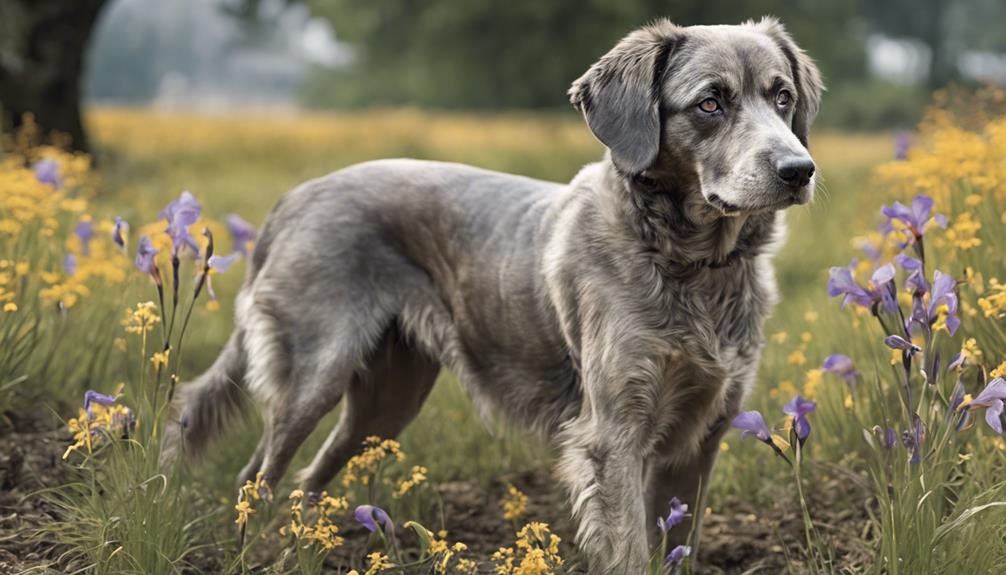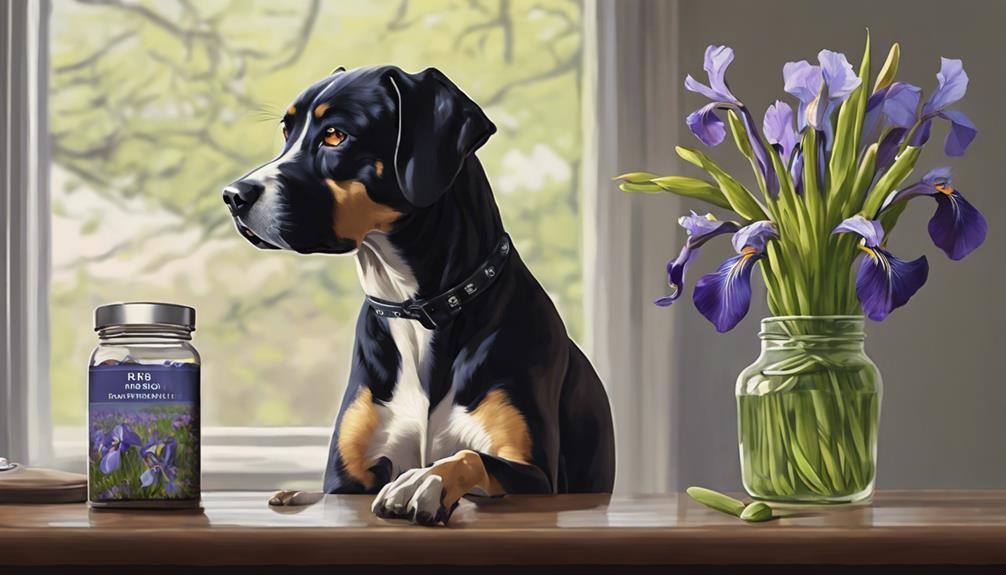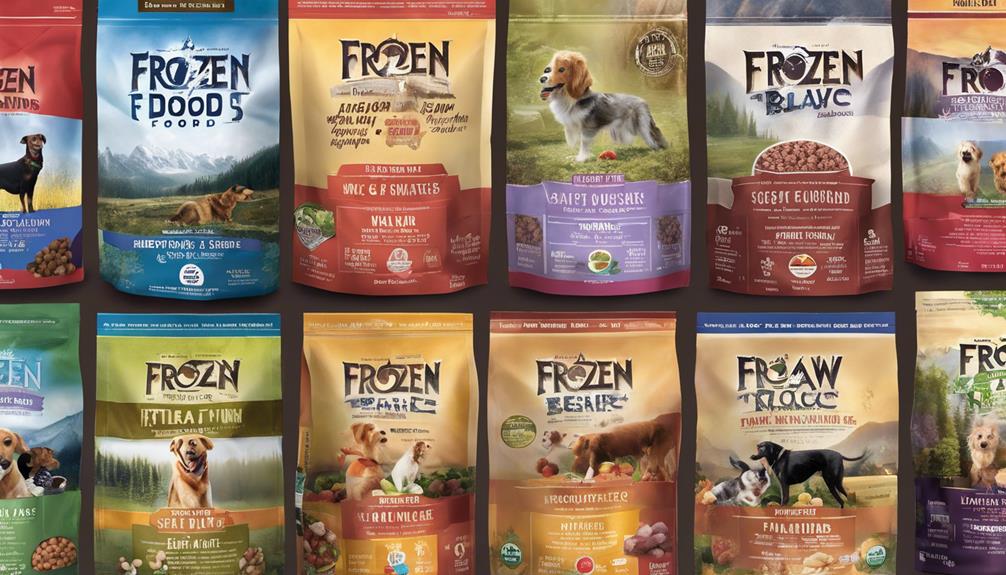Yes, irises can be harmful to dogs. Symptoms include vomiting, diarrhea, salivation, drooling, and lethargy. The seriousness of toxicity depends on factors like plant part and quantity consumed. If your dog ingests irises, remove plant matter, contact a vet, induce vomiting, and provide details to the vet. Essential action is crucial. Pet Poison Helpline offers expert guidance 24/7. Safeguard pets by keeping irises away and opting for pet-friendly plants. Understanding risks and seeking veterinary help promptly is key. Stay informed and prioritize pet safety. Swift action can make a difference in emergencies.
Key Takeaways
- Iris plants are toxic to dogs.
- Symptoms include vomiting, diarrhea, and lethargy.
- Severity depends on plant part and quantity consumed.
- Immediate actions: remove plant matter, contact vet.
- Preventing exposure is crucial for pet safety.
Symptoms of Iris Toxicity in Dogs
If your dog ingests irises, they may experience symptoms of toxicity such as vomiting, diarrhea, salivation, drooling, and lethargy. These signs indicate that the iris plant has had a negative effect on your furry friend's system.
Vomiting and diarrhea are common reactions to the toxic compounds present in irises. The salivation and drooling occur as the body tries to rid itself of the harmful substances. Lethargy, or extreme tiredness, may also be observed in dogs that have ingested irises.
It's important to monitor your dog for these symptoms if they've come into contact with irises. The faster you recognize the signs of toxicity, the sooner you can seek help from a veterinarian.
Factors Influencing Iris Toxicity Severity

Factors influencing the severity of iris toxicity in dogs include the part of the plant ingested and the quantity consumed. When it comes to iris ingestion, understanding these key factors can help determine the level of risk for your furry friend:
- Part of the Plant: The bulbs and rhizomes of irises contain higher concentrations of toxins compared to other parts of the plant. If a dog ingests these specific parts, they may experience more severe symptoms of toxicity.
- Quantity Consumed: The amount of iris ingested plays a significant role in determining the severity of the toxicity. Larger quantities can lead to more pronounced symptoms and potentially life-threatening outcomes.
- Individual Sensitivities: Dogs vary in their sensitivity to toxins, and factors like the dog's size and overall health can influence how they react to iris ingestion. Some dogs may show severe symptoms even with smaller amounts ingested.
Understanding these factors can help pet owners recognize the potential risks associated with iris ingestion and take appropriate actions to protect their dogs from harm.
Immediate Actions for Iris Ingestion

After discovering iris ingestion in your dog, promptly remove any remaining plant matter from their mouth and fur. Symptoms of iris poisoning may include excessive drooling.
It's important to act quickly by contacting your vet for guidance and potential treatment. If advised by your vet, you may need to induce vomiting to help remove any remaining toxins from your dog's system. Additionally, activated charcoal can be administered to help absorb any toxins that may still be present in the digestive tract.
Providing your vet with details such as the part of the iris plant consumed and the quantity ingested can assist in determining the best course of action. Remember, swift action is key in these situations to ensure the safety and well-being of your furry friend.
Pet Poison Helpline Contact Information

Upon discovering iris ingestion in your dog, it's vital to have the Pet Poison Helpline's contact information readily available for immediate assistance. Here are three essential points to keep in mind:
- 24/7 Assistance: The Pet Poison Helpline is a round-the-clock animal poison control service that offers help to pet owners and veterinary professionals. They're well-versed in handling incidents involving toxic plants like irises and can provide guidance in emergencies.
- Expert Guidance: When you call the Pet Poison Helpline at 1-800-213-6680, you'll be connected with specialists who can assess the situation, recommend appropriate treatment, and provide reassurance during stressful times. Having this contact information on hand can be a lifesaver for your furry friend.
- Ensuring Safety: Contacting the Pet Poison Helpline promptly can aid in determining the necessary steps to safeguard your pet's health and well-being. Their expertise can help you navigate through the situation effectively, ensuring the best outcome for your beloved companion. Remember, quick action can make all the difference in a pet poisoning emergency.
Veterinarian Assistance for Iris Exposure

In cases of iris exposure in dogs, prompt veterinary assistance is essential to address potential symptoms and provide necessary treatment. If your dog shows signs like vomiting, diarrhea, or lethargy after coming into contact with irises, contacting a veterinarian immediately is vital.
Veterinarians may induce vomiting to remove any remaining toxins, administer activated charcoal to help absorb the poison, and provide supportive care to manage symptoms. When seeking veterinary assistance, be prepared to provide details about the exposure, such as which part of the plant your dog ingested. This information can aid in determining the best course of treatment.
Risks of Having Irises Around Pets

Keeping irises around pets poses a potential risk due to their toxicity to dogs, primarily attributed to the presence of the compound irisin. Here are three important points to keep in mind about the risks of having irises around pets:
- Toxicity Concerns: Irises contain substances that can be harmful to dogs if ingested, leading to symptoms of iris poisoning. This toxicity can range from mild discomfort to more severe reactions, making it vital to prevent pets from accessing these plants.
- Behavioral Factors: Dogs that like to dig in the garden are particularly at risk of exposure to iris toxins, as the bulbs and rhizomes contain higher concentrations of the harmful compounds. Understanding your pet's behavior can help you take proactive measures to keep them safe.
- Recognizing Symptoms: Being aware of the common symptoms of iris poisoning in dogs, such as vomiting, diarrhea, excessive salivation, drooling, and lethargy, is crucial. Promptly identifying these signs and seeking veterinary care can make a significant difference in your pet's recovery.
Preventing Iris Poisoning Incidents

To prevent iris poisoning incidents in dogs, it's vital to keep irises out of their reach at all times.
Knowing the toxic symptoms of iris ingestion such as vomiting, drooling, and lethargy is key for quick identification.
If your pet ingests any part of an iris plant, contacting a vet immediately can make all the difference in their recovery.
Keep Irises Away
Let's make sure irises are kept out of reach to prevent potential poisoning incidents in dogs. To help you understand why this is important, here are three key points to keep in mind:
- Plant Safety: Irises contain toxins harmful to dogs, especially in their bulbs and rhizomes.
- Prevention is Key: Keeping irises away from areas where your dog plays or digs can help avoid accidental exposure.
- Peace of Mind: By taking simple precautions like fencing off iris plants, you can provide a safer environment for your furry friend.
Know Toxic Symptoms
To recognize and address potential iris poisoning incidents in dogs, it is crucial to be familiar with the toxic symptoms associated with this plant. Dogs may exhibit symptoms like irritation, vomiting, diarrhea, and more if they ingest parts of the iris plant, particularly the bulbs. Here is a table summarizing these toxic symptoms:
| Toxic Symptoms | Description |
|---|---|
| Irritation | Skin or oral irritation may occur. |
| Vomiting | Dogs may vomit after consuming iris. |
| Diarrhea | Diarrhea can be a sign of iris poisoning. |
| Bulbs | Ingesting bulbs can lead to severe symptoms. |
Being aware of these signs can help you act promptly if you suspect your dog has been exposed to iris toxins.
Immediate Vet Assistance
How can we swiftly secure veterinary aid to prevent iris poisoning incidents in our beloved dogs? When faced with a potential iris poisoning situation, immediate vet assistance is essential to guarantee the best outcome for our furry friends. Here are three vital steps to take:
- Contact Your Vet: Reach out to your veterinarian without delay, even if the ingestion seems minor.
- Provide a Sample: Offering a sample of the plant ingested can assist the vet in determining the level of toxicity and the necessary treatment.
- Take Immediate Action: Be prepared to induce vomiting and use activated charcoal as recommended by your vet to prevent further harm.
Conclusion and Pet Safety Reminder

In conclusion, prioritizing pet safety through awareness and proactive measures remains essential in safeguarding our furry companions from potential plant toxins like those found in irises. Understanding the risks associated with poisonous plants and taking steps to prevent exposure is critical in guaranteeing our pets' well-being. By being mindful of the plants we have in our surroundings and opting for pet-friendly alternatives, we can create a safer environment for our beloved dogs.
Regularly monitoring our pets' behavior around plants, especially those known to be toxic like irises, can help in early detection of any potential issues. If there's any suspicion of poisoning, seeking immediate veterinary assistance is crucial to ensure the best possible outcome for our furry friends. Educating ourselves on pet-safe gardening practices and toxic plants is a proactive way to prevent accidental ingestions and keep our pets out of harm's way. Remember, a little awareness and precaution can go a long way in keeping our pets safe from plant toxins.
Frequently Asked Questions
What Happens if a Dog Eats an Iris?
If a dog eats an iris, it may experience symptoms like salivation, vomiting, diarrhea, and decreased energy. This is because irises contain toxic compounds that can harm dogs.
The most potent toxins are found in the bulbs and rhizomes of the plant. Symptoms usually show up within two hours of ingestion, so it's essential to seek immediate veterinary care if you suspect your dog has eaten an iris.
How Poisonous Is Iris?
When it comes to the toxicity of irises, it's important to understand the risks involved for our furry friends. The compound irisin found in irises can be harmful to dogs, especially in the bulbs and rhizomes. If a dog ingests these parts, symptoms like vomiting and lethargy may occur.
To guarantee your pet's safety, immediate veterinary attention is necessary if iris poisoning is suspected. Remember, prevention is key in keeping our canine companions healthy and happy.
How Toxic Are Peonies to Dogs?
Peonies can be harmful to dogs, causing symptoms like vomiting, diarrhea, and decreased energy. It's important to keep these beautiful flowering shrubs out of your pet's reach to prevent accidental ingestion.
If your dog consumes peonies, seek immediate veterinary attention for proper treatment. Remember, the safety and well-being of our furry friends are top priorities, so be cautious about the plants they've access to in and around your home.
Are Butterfly Irises Safe for Dogs?
Butterfly irises are generally safe for dogs. These plants aren't highly toxic if consumed in small amounts. They require low maintenance and can enhance your garden's beauty without posing a significant risk to your furry friends.
While some risks exist, butterfly irises aren't usually a major concern for dog owners. Keeping an eye on your dog's behavior around these plants can help guarantee their safety.
Conclusion
To sum up, it's crucial to bear in mind that iris plants can be harmful to dogs if consumed. As the old adage goes, 'prevention is better than cure.' By recognizing the signs of iris toxicity, taking prompt action if ingestion occurs, and ensuring irises aren't accessible to pets, we can help safeguard our furry companions.
Keep in mind, a little foresight goes a long way in safeguarding our beloved pets from harm. Stay safe and keep those irises away from your pups!










